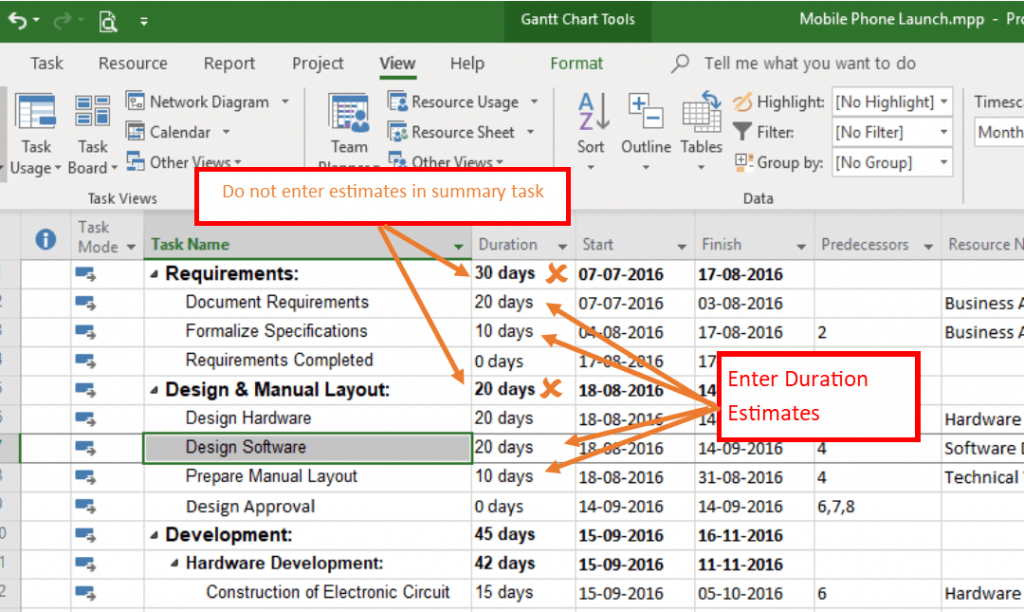Entering Task (Activity) Estimates in MS Project

Questions, this post answers:
What are essential element of MS Project to enter estimates for any task?
Whether I enter duration or work?
Which units I should take for estimates – hours, days, weeks or months?
How to enter duration estimates?
How to enter work estimates?
Essential elements of MS Project for entering task estimates
Entering estimates in MS Project can be called a simple task. However if not done with proper thought process, it may make the life of a project manager difficult. Therefore it is essential for a project manager to understand essential elements of entering estimates in MS Project.
Estimates in MS Project are entered for Tasks (Activities). Therefore estimates are entered only when a good work breakdown structure (WBS) has been created. A good WBS is a WBS which is appropriately broken down. Neither too high nor to detailed. As WBS is the foundation of planning therefore essential to enter task estimates.
Estimating task is not part of MS Project but project manager or subject matter expert should estimates using techniques suitable for their industry and project type. A construction project will use different technique than an engineering project and a software project may take entirely different approach.
Work Vs Duration
The main question before estimating is whether we should estimate work (efforts) or duration for an activity? This entirely depends upon the type of project we have and who will manage the resources on the project.
If we have a construction project on which we will outsource most of the work to contractors, we should estimate in duration. If we have a software project on which we our self will manage the human resources (the development team), we should estimate efforts (work).
Let’s look at the following scenario…
Case 1: 4 labors build a wall in 5 days.
Case 2: How much time 2 labors will take to build the same wall?
| Units (Labors) | Duration |
Work (Efforts) |
|
|
Case 1: |
4 | 5 | 20 |
| Case 2: | 2 | 10 |
20 |
This works on the following formula
Duration = Work/Units or Work = Duration x Units
We observe that efforts remain same on both cases while duration changes as we change number of people on the task. This means if we are in charge of labor (human resource) we should estimate efforts. This will help us to know the duration when we change resources. If we have a fix number of resources, we get to know the duration of the project when we assign these resources to task (Work/Resources) to perform the estimated work and we can give better forecast to our customer. If we have a fix time line, we can assess how many resources will be required to complete the estimated work in the given duration.
On the other side if we are outsourcing our work to contractor, we need not to calculate how many resources we need. This is the work of contractor. Then there is no point estimating efforts. We should estimate duration i.e. in how much time we should accomplish a certain task to meet the project timeline.
Unit of measure for estimates
Which unit of measure we should choose? This will mostly be decided by granularity of our WBS. MS Project provides measurement from minutes to months. We can choose one from minutes, hours, days, weeks or months. Which unit we should choose is based on granularity of WBS and estimation techniques we have used. Most common measurement unit is days. We can enter any unit any time by suffixing the estimate with unit’s abbreviation like 20 d or 4 w for 20 days or 4 weeks. However it is a good idea to set a default unit that we are going to use most of the time. This will reduce our burden of suffixing unit abbreviation every time we enter estimate. To do this, go to File à Options à Schedule and change the unit of measure. Please refer the figure below…
Entering Estimates
Entering duration estimate
To enter duration estimate, go to Gantt Chart view and enter duration estimate against each tasks in the duration column. Duration column is there in Gantt Chart view by default. Please refer the figure below…
Duration of summary tasks is calculated by Microsoft Project based duration of each task under it and dependencies among them. We must not enter duration estimate for any summary tasks.
Entering work estimate
To enter work estimate, go to Gantt Chart view. “Work” column is not in the Gantt Chart view by default. Therefore we need to insert work column. For this, right click on Duration column header (as such any header where we want to insert column), in the context menu, select “Insert Column”. MS Project will provide a drop down to select a field. We start tying “Work” to search for work column and then select “Work” to insert work column.
We can enter work (efforts in person days) in this column as we did for duration against each activity. Please refer the figure below…
Again remember that work of summary tasks is calculated by Microsoft Project based on tasks under it. We must not enter work estimate for any summary tasks.
I would like to know how was your experience with entering estimates in Microsoft Project? Did you face any problem? Do you have any idea to make it simpler or easier? I look forward for your views, comments and question.


